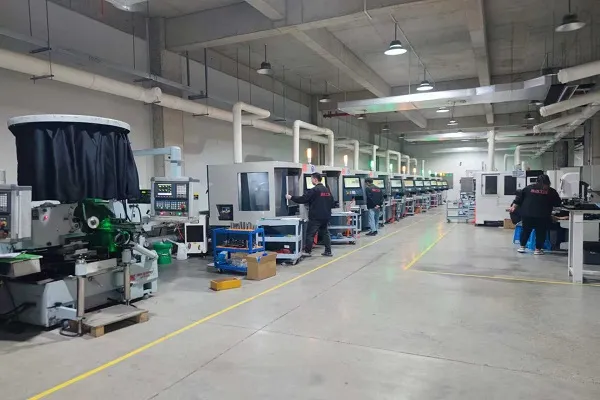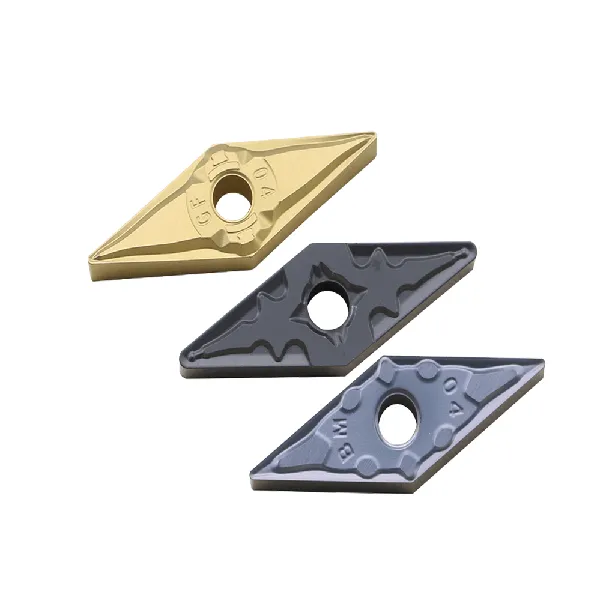
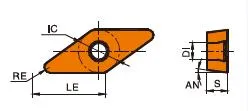
VCGTインサート
VCGT insert angle :35 degree 7° Positive Rake Insert with single-sided Chipbreaker;
Screw-On Insert, Finshing machining;
Matching VCGT insert Tool Holder: SVJBR/L, SVABR/L, SVVBN, SVQBR/L, SVUBR/L;
Range of VCGT insert types:(ISO)VCGT160404/ VCGT160408/ VCGT110302/ VCGT110304(ANSI) VCGT331;
VCGT Insert can deal with multiple operations by combining different chip breakers and grades;
材料:タングステンカーバイド;
Product Introduction
The VCGT insert is specially designed for aluminium alloy lathe machining, with a dedicated chipbreaker, which not only eliminates the problem of chip entanglement that occurs during aluminium alloy finishing, but also provides an excellent surface finish.
Key Features
- 形: VCCT inserts feature an 80° rhombic (diamond) shape, giving them four cutting edges which provides cost-effectiveness.
- Positive Rake Angle: The cutting face slopes slightly forward from the cutting edge. This often produces a smoother cut with less cutting force, suitable for specific material types.
- クリアランス角度: Typically around 7° to help prevent rubbing against the workpiece.
- Sharp Cutting Edge: The acute corner radius promotes better surface finishes, especially for finishing operations.
- Chipbreakers: VCGT inserts may have chipbreakers on one or both sides to influence chip formation and control.
- Coatings: Often coated with materials like TiN, AlTiN, etc., to improve wear resistance and tool life.
VCGT insert Specification
Understanding the VCGT Code
The letters and numbers in the VCGT designation tell you about the insert:
- V: 80° rhombic shape
- 子: 7° clearance angle
- G: Indicates the specific hole and chipbreaker design (varies by manufacturer)
- T: Indicates tolerance class (precision of size)
- Numbers:
- Typically, the first two numbers represent the inscribed circle (size of the diamond) in sixteenths of an inch (or directly in millimeters for ISO codes).
- The third number represents thickness in sixteenths of an inch.
- The last number often indicates the nose radius (smaller means sharper).
VCGT insert holder(Boring bar)
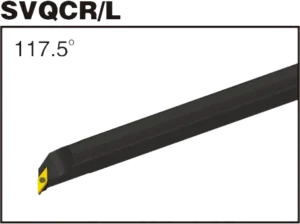

SVQBR/L
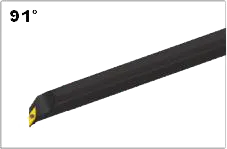
SVUBR/L

Carbide VCGT Insert Dimensions (ISO)
| Designation | 内接円 (IC) | 厚さ | コーナー半径 |
|---|---|---|---|
| VCGT 110302 | 11mm (0.43") | 3.18mm (0.125") | 0.2mm (0.008") |
| VCGT 110304 | 11mm (0.43") | 3.18mm (0.125") | 0.4mm (0.016") |
| VCGT 160404 | 16mm (0.63") | 4.76mm (0.187") | 0.4mm (0.016") |
| VCGT 160408 | 16mm (0.63") | 4.76mm (0.187") | 0.8mm (0.031") |
Example: VCGT 160402 (ISO)
- 80° rhombic shape, positive rake insert.
- Inscribed circle of 12.7mm (approx. 1/2″).
- Thickness of 3.18mm (approx. 1/8″).
- Specific chipbreaker/hole design.
The Science Behind Carbide Inserts: How They're Made and Why They're So Strong
超硬インサートは、入手可能な切削工具の中で最も多用途で耐久性のあるものの一部です。しかし、それらはどのように作られるのでしょうか?そして何が彼らをそんなに強いのでしょうか?このビデオでは、炭化タングステンの特性から製造プロセスまで、超硬インサートの背後にある科学を探求します。
当社の生産能力

